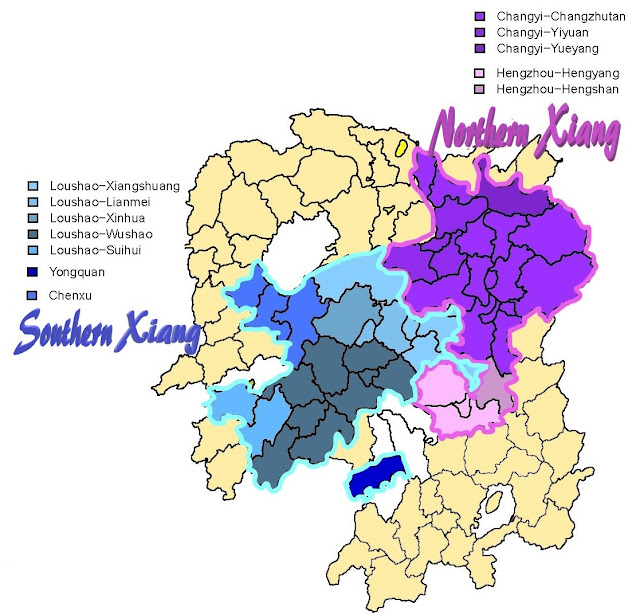Introduction
The Xiang (湘) Chinese aka Hunanese is the main Chinese language spoken in Hunan province in China. Xiang is named after the main river that flows in the province.
This article talks about the origin of the Xiang Chinese language which originated from an ancient Chinese language.
Chu kingdom
When the Shang dynasty started to expand their kingdom around 16th century BC, a Hua-Xia (ancestors of Han Chinese) tribe was forced to migrate from Henan to Jing (荊) mountains in modern-day Nanzhang (南漳) country in Hubei province. |
| Migration path of Chu people |
They called themselves Chu (楚) people; 'Chu' was named after a type of multi-purpose shrub that was widely found in Hubei where they lived. The Chu tribe is one of the eight tribes who are descendants of Zhu-Rong (祝融); one of its earliest leaders was Mi Yu Xiong (芈鬻熊).
They formed the Chu state in 11th century BC and subsequently the Chu kingdom in 7th century BC. From 757-523 BC, the Chu kingdom expanded its territory south into Xiang River basin in Hunan. It also gradually expanded its territory to include the middle and lower reaches of Yangtze River basin by 260 BC. However, the Chu kingdom was annexed by the Qin dynasty in 223 BC.
The video below is a Mandarin historical documentary on the origin of the Chu kingdom.
Classification of Xiang languages
Pervasive influence from Southwestern Mandarin language in north, west and south of Hunan has in the past made the Xiang languages difficult to classify.
The map below illustrates the latest sub-classification of languages within the Northern Xiang and the Southern Xiang branches. Note the convention of Language-Dialect e.g. Changyi-Yiyuan, Loushao-Lianmei , there are 2 different languages in Northern Xiang and 3 different languages in Southern Xiang.
Only the origin of the two main branches would be revealed in the next two sections.
Southern Xiang
There were three dialects of the ancient Chu language which are West, South and East Chu.The South Chu dialect developed into Southern Xiang languages and is mainly spoken in central Hunan province today. The two most prominent dialects are Shuangfeng (雙峰) and Xiang-Xiang (湘鄉)
These languages in central Hunan remained largely intact from the influence of migrants from other provinces due to its central position in Hunan which preserved more features of ancient Chu language.
Northern Xiang
Around the end of the Tang dynasty and before Song dynasty from 875-960 AD, a massive number of Han Chinese from adjacent Jiangxi province migrated to the north east region around Changsha (長沙).Therefore, the original proto-Southern Xiang language in eastern Hunan region was supplanted by the influx of Gan speakers from Jiangxi province, which later developed into Northern Xiang languages. The most prominent dialect is Changsha dialect which is spoken in the capital of Hunan province.
 |
| Migration path in dark red arrow |
Language features
The most significant difference between the Southern and Northern branch is the change of all voiced initial consonants into voiceless unaspirated as shown in the table below.Furthermore, the Southern branch doesn't have the 'F' initial consonant of Northern branch as shown in the table below. This is due to the fact that Old Chinese originally doesn't have this sound which developed later in Middle Chinese.
English
|
Chinese
|
Southern- Chengbu
|
Northern- Changsha
|
| white |
白
|
Ba | Pe |
| peach |
桃
|
Dao | Tao |
| sit |
坐
|
Dzo | Tso |
| together |
共
|
Gong | Kong |
| wind |
風
|
Hang | Feng |
The video below illustrates the sounds from native speakers of Northern and Southern Xiang languages.
Conclusion
Xiang Chinese languages are descendant languages of the ancient Chu kingdom spoken by the Han Chinese in that kingdom.Southern Xiang is a direct descendant of South Chu dialect, which is an Old Chinese dialect, whereas Northern Xiang is essentially a Middle Chinese descendant which merged with the Southern Xiang language.
The East Chu dialect is one of the ancestral languages of modern Wu language whose origin was told in the 'Origin of Wu language' article. The Wu languages inherited some Chu words due to a common origin with the Xiang languages.
The North Chu dialect has probably gone extinct as Hubei province is now dominated by Southwestern Mandarin speakers.
Related links
Origin of Wu language
http://eastasiaorigin.blogspot.com/2018/10/origin-of-wu-language.html
Origin of Gan language
http://eastasiaorigin.blogspot.my/2017/11/origin-of-gan-language.html
Origin of Gan language
http://eastasiaorigin.blogspot.my/2017/11/origin-of-gan-language.html
Sources
- Chinese history of Chu <楚居>
- History of migration of Hunan people. 湖南人口變遷史 Author: Wang Yong 王勇
- History of Hunan. 湖南通鑑. published by 湖南省地方志編纂委員會.
- https://kknews.cc/culture/b4g4op9.html
- http://www.teacher.aedocenter.com/mywebB/Newbook-8/cnn-20.htm
- http://hakka.ncu.edu.tw/hakka/modules/tinycontent/content/paper/paper110/05_19.html
Last updated: 16 June 2020
Copyright © eastasiaorigin.blogspot 2019. All rights reserved.



Comments
Post a Comment